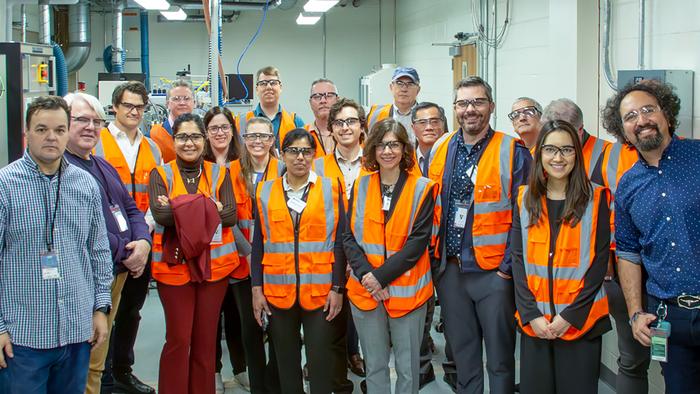More than 120 people gathered for the 2024 Innovation Network for Fusion Energy (INFUSE) Workshop at the U.S. Department of Energy’s (DOE) Princeton Plasma Physics Laboratory (PPPL) from Feb. 27-28.

Credit: Michael Livingston, PPPL
More than 120 people gathered for the 2024 Innovation Network for Fusion Energy (INFUSE) Workshop at the U.S. Department of Energy’s (DOE) Princeton Plasma Physics Laboratory (PPPL) from Feb. 27-28.
The event, which was sponsored by the DOE’s Office of Fusion Energy Sciences (FES), is a part of the INFUSE awards program that funds laboratories or universities so they can partner with private sector companies working on the science and technology solutions that will bring fusion energy to the power grid. To date, the DOE has granted 90 awards, with most ranging from $100,000 to $350,000 for a 12-month project.
“The INFUSE program continues to help bring together the accumulated knowledge and expertise developed in national labs and universities with the private companies that want to reduce risks and drive their technologies forward,” said Erik Gilson, INFUSE deputy director and head of PPPL’s Discovery Plasma Science Department. “These types of public-private partnerships really bring out the best in each sector. I’m excited to see what new partnerships emerge as the result of people networking at the workshop.”
Developing a system for using fusion as a source of electricity is as important as it is complex.
Fusion could support our ever-growing need for energy without contributing to carbon emissions. But the challenge is arduous and multifaceted, as fusion requires new materials, engineering and software.
“I believe we are going to conquer this issue of making fusion cheap enough for the market, but it would sure be nice if it were soon,” said PPPL Lab Director Steven Cowley during his opening remarks at the workshop.
Cowley said he believes part of overcoming the challenges to bringing fusion energy to the power grid is embracing public-private partnerships and noted that, ultimately, it will be private industry that brings fusion to the market efficiently. “We are here to support you,” he told workshop attendees.
“The tone of the meeting was set based on what we heard from the respondents to a survey from a previous virtual workshop, which showed the greatest need was for networking opportunities,” said Arnie Lumsdaine, INFUSE director and group leader of fusion engineering at Oak Ridge National Laboratory. Consequently, technical sessions were kept to a minimum, with the bulk of the two-day program offering opportunities for private companies to learn more about what each national lab had to offer and discuss collaboration possibilities.
Scott Hsu, senior advisor and lead fusion coordinator in the Office of the Under Secretary for Science and Innovation at the DOE, explained the elements essential to realizing President Joe Biden’s “Bold Decadal Vision” for fusion energy. “We want to ensure that fusion is a leader in supporting a clean energy transition,” said Hsu. This, he explained, requires everything from closing the science and technology gaps to building a fusion pilot plant, establishing reliable supply chains –– especially for fusion fuels, developing a waste management strategy, instituting regulatory frameworks, and establishing external partnerships, including with state and local governments, nongovernmental organizations, academia and the private sector.
Fermi National Accelerator Laboratory (Fermilab) Scientist Maria Baldini was among the many representatives from the national labs. “This workshop offers me a good opportunity to meet people in the private sector,” Baldini said. “We are trying to develop a program to study the properties of a new kind of conductor under different engineering constraints that would be used for fusion machines, and it would be good for me to know the people in the private sector who produce this conductor and try to think about how we can collaborate.”
In addition to opportunities to network, the workshop offered a lengthy question-and-answer session with Fusion Industry Association Chief Executive Officer Andrew Holland, tours of PPPL, technical sessions, presentations about successful INFUSE projects and information about the Cooperative Research and Development Agreement (CRADA) process.
PPPL’s Strategic Partnership Officer David Zimmerman was one of the speakers providing advice on the CRADA process. “You can see from the number of applications that the INFUSE program generates and the number of grant awards that it makes that this program is really driving public-private partnerships,” said Zimmerman. “I think it’s a fantastic mechanism program to advertise laboratory capabilities to fusion companies and to give laboratories an opportunity to engage with this exciting new fusion industry.”
Aaron Froese, a computational plasma physicist at General Fusion in British Columbia, Canada, said the INFUSE awards have allowed the company to extend research critical to advancing their magnetized target fusion technology for commercialization. In a General Fusion commercial power plant, the company says a plasma liner made of liquid lithium will improve device longevity (by shielding structural components from fast fusion neutrons), increase the tritium breeding ratio and act as the medium to transfer the kinetic energy from the compression drivers, addressing the significant barriers to commercialization. General Fusion has worked with several U.S. national labs under INFUSE awards, including PPPL, Oak Ridge National Laboratory and Savannah River National Laboratory. “The administration has been very receptive to our endeavors,” Froese said. “I think it’s a very well-run program.”
PPPL is mastering the art of using plasma — the fourth state of matter — to solve some of the world’s toughest science and technology challenges. Nestled on Princeton University’s Forrestal Campus in Plainsboro, New Jersey, our research ignites innovation in a range of applications including fusion energy, nanoscale fabrication, quantum materials and devices, and sustainability science. The University manages the Laboratory for the U.S. Department of Energy’s Office of Science, which is the nation’s single largest supporter of basic research in the physical sciences. Feel the heat at https://energy.gov/science and https://www.pppl.gov.




